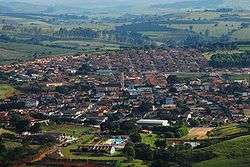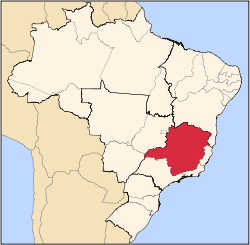Cássia
| Cassia | |
|---|---|
| Municipality | |
 Location of Cássia within the state of Minas Gerais | |
| Coordinates: 20°35′S 48°55′W / 20.583°S 48.917°WCoordinates: 20°35′S 48°55′W / 20.583°S 48.917°W | |
| Country |
|
| Region | Southeast |
| State | Minas Gerais |
| Mesoregion | Oeste de Minas |
| Time zone | UTC -3 |
Cássia is a Brazilian municipality located in the center of the state of Minas Gerais.[1][2][3][4] Its population as of 2000 was 17,027 people living in a total area of 643 km². The city belongs to the meso-region of Sul e Sudoeste de Minas and to the micro-region of Passos. It became a municipality in 1890.[5]
Location
The city center of Cássia is located at an elevation of 745 meters in a fertile region between the state boundary of São Paulo and the great reservoir of Furnas. Neighboring municipalities are: Delfinópolis (N), Passos and Itaú de Minas (E), Pratápolis (S), Captetinga (SW), and Ibiraci (W).[6]
Distances
- Belo Horizonte: 384 km (south on MG-344, then east on MG-050)
- São Sebastião do Paraíso: 65 km (31 southeast on MG-344, then 34 km southwest on MG-050)
- Ibiraci: 27 km northwest on MG-344
Economic activities
Services and agriculture are the main economic activities. The GDP in 2005 was approximately R$135 million, with 71 million reais from services, 10 million reais from industry, and 45 million reais from agriculture. There were 884 rural producers on 48,000 hectares of land. Approximately 2,700 persons were occupied in agriculture. The main crops are coffee, sugarcane, rice, beans, and corn. There were 55,000 head of cattle, of which 18,000 were milk cows (2006).[5]

Of the working force there were 555 workers in 187 small industries and 802 workers in 422 retail units.
There are 4 banks (2007) [9]
In the vehicle fleet there were 2,896 automobiles, 349 trucks, 336 pickup trucks, 26 buses, and 622 motorcycles (2007).[5]
Health and education
In the health sector there were 10 health establishments, which included 6 public health clinics, 3 private clinics, and 1 private hospital with 46 beds (2005). Educational needs of 3,700 students were met by 10 primary schools, 2 middle schools, and 12 pre-primary schools.[5]
- Municipal Human Development Index: 0.777 (2000)
- State ranking: 126 out of 853 municipalities as of 2000
- National ranking: 1,134 out of 5,138 municipalities as of 2000
- Literacy rate: 86%
- Life expectancy: 74 (average of males and females)[10]
In 2000 the per capita monthly income of R$257.00 was below the state average of R$276.00 and below the national average of R$297.00. Poços de Caldas had the highest per capita monthly income in 2000 with R$435.00. The lowest was Setubinha with R$73.00.
The highest ranking municipality in Minas Gerais in 2000 was Poços de Caldas with 0.841, while the lowest was Setubinha with 0.568. Nationally the highest was São Caetano do Sul in São Paulo with 0.919, while the lowest was Setubinha. In more recent statistics (considering 5,507 municipalities) Manari in the state of Pernambuco has the lowest rating in the country—0,467—putting it in last place.[10]
See also
References
- ↑ "Divisão Territorial do Brasil" (in Portuguese). Divisão Territorial do Brasil e Limites Territoriais, Instituto Brasileiro de Geografia e Estatística (IBGE). July 1, 2008. Retrieved December 17, 2009.
- ↑ "Estimativas da população para 1º de julho de 2009" (PDF) (in Portuguese). Estimativas de População, Instituto Brasileiro de Geografia e Estatística (IBGE). August 14, 2009. Retrieved December 17, 2009.
- ↑ "Ranking decrescente do IDH-M dos municípios do Brasil" (in Portuguese). Atlas do Desenvolvimento Humano, Programa das Nações Unidas para o Desenvolvimento (PNUD). 2000. Archived from the original on October 3, 2009. Retrieved December 17, 2009.
- ↑ "Produto Interno Bruto dos Municípios 2002-2005" (PDF) (in Portuguese). Instituto Brasileiro de Geografia e Estatística (IBGE). December 19, 2007. Archived from the original (PDF) on October 2, 2008. Retrieved December 17, 2009.
- 1 2 3 4 IBGE Archived January 9, 2007, at the Wayback Machine.
- ↑ Citybrazil
- ↑ DERMG
- ↑ A onde fica
- ↑ Prefeitura Municipal de Passos
- 1 2 Frigoletto
| Wikimedia Commons has media related to Cássia (Minas Gerais). |
